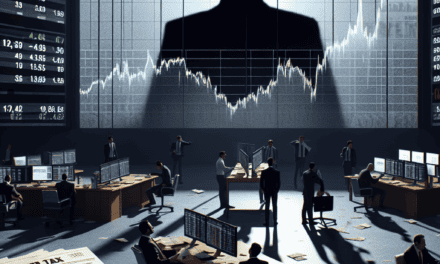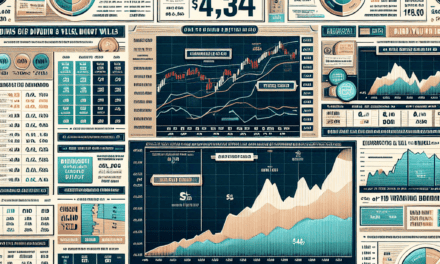“After the High: Navigating the Calm in Market Momentum”
Introduction
In the wake of a historic surge that captivated investors and analysts alike, market momentum has begun to wane, signaling a potential shift in the financial landscape. This deceleration follows a period of unprecedented growth, driven by a confluence of factors including robust economic data, accommodative monetary policies, and heightened investor optimism. As the initial euphoria subsides, market participants are now recalibrating their strategies, grappling with emerging uncertainties and reassessing valuations. This wrap-up delves into the dynamics that fueled the recent rally, examines the causes behind the current slowdown, and explores the implications for future market trajectories.
Understanding Market Momentum: Key Factors Behind the Recent Surge
Market momentum, a critical concept in financial markets, refers to the tendency of asset prices to continue moving in the same direction for a period of time. This phenomenon has been particularly evident in recent months, as markets experienced a historic surge. Understanding the key factors behind this momentum is essential for investors and analysts alike, as it provides insights into the underlying dynamics driving asset prices.
One of the primary drivers of the recent market surge has been the unprecedented monetary policy measures implemented by central banks worldwide. In response to economic challenges, central banks have maintained low interest rates and engaged in large-scale asset purchases, commonly known as quantitative easing. These actions have injected significant liquidity into the financial system, encouraging investment in riskier assets and fueling upward momentum in markets. As a result, investors have been more willing to allocate capital to equities and other high-yielding investments, contributing to the sustained rally.
In addition to monetary policy, fiscal stimulus measures have played a crucial role in bolstering market momentum. Governments around the globe have introduced substantial fiscal packages aimed at supporting businesses and households during economic downturns. These measures have not only provided a safety net for the economy but have also instilled confidence among investors, who anticipate a quicker recovery. Consequently, the combination of fiscal and monetary support has created a favorable environment for markets, driving asset prices higher.
Moreover, technological advancements and the rapid digital transformation of industries have further contributed to the recent market surge. The pandemic accelerated the adoption of digital technologies, leading to increased demand for tech-related stocks. Companies in sectors such as e-commerce, cloud computing, and digital payments have experienced significant growth, attracting investor interest and pushing their valuations to new heights. This shift towards technology-driven investments has been a key factor in sustaining market momentum.
However, it is important to recognize that market momentum is not solely driven by economic fundamentals. Investor sentiment and behavioral factors also play a significant role. During periods of strong momentum, positive sentiment can create a self-reinforcing cycle, where rising prices attract more investors, further driving prices up. This phenomenon, often referred to as “herd behavior,” can amplify market movements and contribute to the persistence of momentum. Understanding these psychological dynamics is crucial for comprehending the recent surge and its potential implications.
Despite the factors supporting market momentum, it is essential to acknowledge that such surges are not indefinite. As markets reach elevated levels, concerns about valuations and potential corrections begin to surface. Investors may start to question whether current prices accurately reflect underlying fundamentals, leading to increased volatility and potential reversals. Additionally, any changes in monetary or fiscal policy, such as interest rate hikes or reduced government spending, could dampen market momentum and trigger a shift in investor sentiment.
In conclusion, the recent historic surge in market momentum can be attributed to a combination of monetary and fiscal policy measures, technological advancements, and investor sentiment. While these factors have driven asset prices to new heights, it is crucial for investors to remain vigilant and consider the potential risks associated with elevated valuations. As market momentum begins to wane, understanding the key drivers behind the surge will be instrumental in navigating the evolving financial landscape.
Analyzing the Waning Momentum: What Investors Need to Know
In recent months, the financial markets have experienced a notable shift in momentum, following a historic surge that captured the attention of investors worldwide. This change in pace has prompted a reevaluation of strategies and expectations, as market participants seek to understand the underlying factors contributing to this transition. As the initial euphoria of the surge begins to wane, it is crucial for investors to grasp the dynamics at play and adjust their approaches accordingly.
The recent surge in market activity was driven by a confluence of factors, including unprecedented fiscal stimulus, accommodative monetary policies, and a robust recovery in consumer demand. These elements combined to create an environment ripe for growth, propelling stock indices to record highs and fostering a sense of optimism among investors. However, as the effects of these stimulative measures begin to taper, the market’s momentum has shown signs of deceleration.
One of the primary reasons for this waning momentum is the gradual withdrawal of fiscal support. Governments around the world, having deployed significant resources to mitigate the economic impact of the pandemic, are now facing the challenge of balancing fiscal responsibility with continued support for growth. As stimulus measures are scaled back, the market is adjusting to a new reality where growth may not be as robust as it was during the height of the stimulus-driven surge.
Moreover, central banks are beginning to signal a shift in monetary policy. With inflationary pressures mounting, policymakers are contemplating the need to tighten monetary conditions to prevent overheating. This potential shift in policy has introduced a degree of uncertainty into the market, as investors grapple with the implications of rising interest rates on asset valuations and economic growth. The anticipation of tighter monetary policy has already led to increased volatility, as market participants reassess their risk exposures in light of changing conditions.
In addition to these macroeconomic factors, geopolitical tensions have also played a role in tempering market enthusiasm. Ongoing trade disputes, coupled with regional conflicts and political uncertainties, have added layers of complexity to the investment landscape. These geopolitical risks have the potential to disrupt supply chains, impact commodity prices, and influence investor sentiment, further contributing to the market’s waning momentum.
Despite these challenges, it is important to recognize that the market’s deceleration does not necessarily signal an impending downturn. Rather, it reflects a normalization process as the extraordinary conditions that fueled the surge begin to subside. Investors should view this period as an opportunity to reassess their portfolios, ensuring that they are well-positioned to navigate the evolving landscape.
In light of these developments, diversification remains a key strategy for managing risk. By spreading investments across a range of asset classes and geographies, investors can mitigate the impact of localized disruptions and capitalize on opportunities in different sectors. Additionally, maintaining a long-term perspective is crucial, as short-term fluctuations are an inherent part of market dynamics.
In conclusion, the waning momentum in the financial markets is a natural progression following a period of unprecedented growth. As investors adapt to this new phase, understanding the interplay of fiscal, monetary, and geopolitical factors will be essential. By staying informed and maintaining a disciplined approach, investors can navigate the challenges and opportunities that lie ahead, ensuring that their portfolios remain resilient in the face of changing market conditions.
Historical Context: Comparing Past Market Surges and Their Aftermath
The financial markets have always been a reflection of the broader economic landscape, with periods of exuberance often followed by phases of correction. The recent historic surge in market momentum has captured the attention of investors and analysts alike, prompting comparisons with past market surges and their subsequent aftermaths. Understanding these historical contexts provides valuable insights into the current market dynamics and potential future trajectories.
To begin with, it is essential to recognize that market surges are not a novel phenomenon. Throughout history, there have been numerous instances where markets have experienced rapid ascents, driven by a confluence of factors such as technological advancements, monetary policy shifts, or geopolitical developments. For instance, the dot-com boom of the late 1990s was characterized by an unprecedented rise in technology stocks, fueled by optimism about the internet’s transformative potential. Similarly, the housing market surge in the early 2000s was underpinned by low interest rates and lax lending standards, which eventually culminated in the financial crisis of 2008.
In comparing these past surges to the recent market momentum, it becomes evident that while the catalysts may differ, the underlying patterns often exhibit striking similarities. Typically, a surge is marked by heightened investor enthusiasm, leading to inflated asset valuations and increased market volatility. This phase is often followed by a period of introspection, where market participants reassess the sustainability of the growth and adjust their strategies accordingly. The current market environment, characterized by a post-pandemic recovery and unprecedented fiscal stimulus, mirrors these historical patterns to a significant extent.
Moreover, the aftermath of past market surges provides crucial lessons for navigating the present landscape. Historically, the transition from a surge to a more stable market environment has been accompanied by a recalibration of investor expectations and a focus on fundamentals. For example, following the dot-com bust, there was a renewed emphasis on profitability and sustainable business models, which ultimately paved the way for the growth of tech giants that dominate today’s market. Similarly, the post-2008 recovery was marked by regulatory reforms and a shift towards more prudent financial practices.
In light of these historical precedents, the waning momentum in the current market can be seen as a natural progression rather than an anomaly. As investors grapple with concerns over inflation, interest rate hikes, and geopolitical tensions, there is a growing recognition of the need for a more measured approach. This shift is reflected in the increased scrutiny of corporate earnings, the reevaluation of growth projections, and a more cautious stance towards speculative investments.
Furthermore, the historical context underscores the importance of diversification and risk management in navigating market cycles. While past surges have often been concentrated in specific sectors or asset classes, the subsequent corrections have highlighted the benefits of a balanced portfolio. By spreading investments across a range of assets, investors can mitigate the impact of market volatility and position themselves for long-term success.
In conclusion, the current market environment, with its waning momentum following a historic surge, is not without precedent. By examining past market surges and their aftermaths, investors can gain valuable insights into the potential challenges and opportunities that lie ahead. As history has shown, while market cycles are inevitable, a thoughtful and informed approach can help navigate the complexities of the financial landscape and achieve sustainable growth.
Investor Strategies: Navigating a Market with Waning Momentum
In the wake of a historic surge that saw unprecedented gains across various sectors, market momentum is beginning to wane, prompting investors to reassess their strategies. This shift in market dynamics requires a nuanced understanding of the factors at play and a strategic approach to navigating the evolving landscape. As the initial euphoria subsides, investors are now faced with the challenge of maintaining gains while mitigating potential risks associated with a cooling market.
The recent surge was driven by a confluence of factors, including robust economic recovery, fiscal stimulus, and technological advancements that fueled investor optimism. However, as these catalysts begin to lose their potency, the market is entering a phase characterized by increased volatility and uncertainty. In this context, investors must adopt a more cautious and diversified approach to safeguard their portfolios against potential downturns.
One of the key strategies in navigating a market with waning momentum is to focus on diversification. By spreading investments across a variety of asset classes, sectors, and geographies, investors can reduce their exposure to specific risks and enhance their potential for long-term returns. This approach not only helps in mitigating the impact of market fluctuations but also provides opportunities to capitalize on growth in different areas. Moreover, diversification can be complemented by a thorough analysis of market trends and economic indicators, enabling investors to make informed decisions based on data-driven insights.
In addition to diversification, maintaining a long-term perspective is crucial in a market experiencing waning momentum. Short-term market fluctuations can often lead to impulsive decision-making, which may not align with an investor’s overall financial goals. By focusing on long-term objectives and maintaining discipline, investors can avoid the pitfalls of reactive trading and instead concentrate on building a resilient portfolio that can withstand market volatility. This approach is particularly important in times of uncertainty, as it allows investors to remain focused on their strategic goals rather than being swayed by temporary market movements.
Furthermore, investors should consider incorporating defensive assets into their portfolios as a means of hedging against potential downturns. Defensive assets, such as bonds and dividend-paying stocks, tend to perform well during periods of market instability, providing a buffer against losses. By including these assets in their investment mix, investors can enhance the stability of their portfolios and reduce the impact of market volatility on their overall returns.
Another important consideration is the role of active management in navigating a market with waning momentum. While passive investment strategies have gained popularity in recent years, active management can offer significant advantages in a volatile market environment. Skilled fund managers can identify opportunities and risks that may not be apparent through passive strategies, allowing for more agile and responsive investment decisions. By leveraging the expertise of active managers, investors can better position themselves to capitalize on emerging trends and mitigate potential risks.
In conclusion, as market momentum wanes following a historic surge, investors must adopt a strategic and informed approach to navigate the evolving landscape. By focusing on diversification, maintaining a long-term perspective, incorporating defensive assets, and considering active management, investors can effectively manage risks and position themselves for sustained success. As the market continues to evolve, these strategies will be essential in ensuring that investors remain resilient and adaptable in the face of changing dynamics.
Economic Indicators: Signals of a Slowing Market Momentum
In recent months, the economic landscape has been characterized by a notable shift in market momentum, following a period of unprecedented growth. This transition has been marked by a series of economic indicators that suggest a deceleration in the pace of market activity. As we delve into these signals, it becomes evident that the once robust surge is now giving way to a more tempered economic environment.
To begin with, one of the most telling indicators of this slowing momentum is the recent performance of the stock market. After reaching historic highs, major indices have shown signs of volatility and stagnation. This change can be attributed to a variety of factors, including investor concerns over inflationary pressures and geopolitical uncertainties. As a result, market participants have adopted a more cautious approach, leading to reduced trading volumes and increased market fluctuations.
In addition to stock market performance, consumer confidence has also exhibited signs of waning. Surveys conducted over the past few months indicate a decline in consumer optimism, which can be linked to rising costs of living and uncertainty about future economic conditions. This dip in confidence is significant, as consumer spending is a critical driver of economic growth. Consequently, a more conservative spending pattern among consumers could further contribute to the slowing market momentum.
Moreover, the labor market, which had been a pillar of strength during the surge, is now showing mixed signals. While unemployment rates remain relatively low, job creation has slowed, and wage growth has not kept pace with inflation. This situation presents a complex challenge, as it suggests that while employment opportunities are available, the quality and compensation of these jobs may not be sufficient to sustain the previous levels of economic expansion.
Transitioning to the housing market, another key economic indicator, we observe a cooling trend. After a period of rapid price increases and high demand, the housing sector is experiencing a slowdown. Rising interest rates have made mortgages more expensive, thereby dampening buyer enthusiasm and leading to a decrease in home sales. This shift not only affects the real estate market but also has broader implications for related industries, such as construction and home goods.
Furthermore, global supply chain disruptions continue to pose challenges, exacerbating the slowing momentum. The lingering effects of the pandemic, coupled with geopolitical tensions, have led to bottlenecks and delays in the production and distribution of goods. These disruptions have contributed to inflationary pressures, further complicating the economic outlook and impacting both businesses and consumers.
In light of these developments, policymakers and economic analysts are closely monitoring the situation. Central banks, in particular, face the delicate task of balancing interest rate adjustments to curb inflation without stifling growth. Their decisions in the coming months will be crucial in determining the trajectory of the market and the broader economy.
In conclusion, the current economic indicators paint a picture of a market that is transitioning from a period of rapid growth to one of more measured activity. While the historic surge provided significant gains, the present signals suggest a need for caution and adaptability. As we navigate this evolving landscape, understanding these indicators will be essential for stakeholders seeking to make informed decisions in an increasingly complex economic environment.
Expert Insights: Predictions for the Market’s Next Phase
In the wake of a historic surge that saw unprecedented gains across various sectors, market momentum appears to be waning, prompting investors and analysts to reassess their strategies and predictions for the next phase. This shift in market dynamics has sparked a flurry of expert insights, each offering a unique perspective on what the future may hold. As the dust begins to settle, it is crucial to understand the factors contributing to this slowdown and the potential implications for the broader economic landscape.
Initially, the surge was driven by a confluence of factors, including robust economic recovery post-pandemic, significant fiscal stimulus, and a surge in consumer spending. These elements combined to create an environment ripe for growth, with many companies reporting record profits and stock prices reaching all-time highs. However, as the initial euphoria subsides, several underlying challenges have emerged, casting a shadow over the market’s future trajectory.
One of the primary concerns is the potential for rising inflation, which has been exacerbated by supply chain disruptions and increased demand for goods and services. Inflationary pressures have led to speculation about potential interest rate hikes by central banks, which could dampen economic growth and reduce investor appetite for riskier assets. Furthermore, geopolitical tensions and regulatory changes in key markets have added an additional layer of uncertainty, prompting investors to adopt a more cautious approach.
In light of these developments, experts are divided on their predictions for the market’s next phase. Some analysts argue that the current slowdown is merely a temporary correction, suggesting that the underlying fundamentals remain strong and that the market will continue to grow, albeit at a more measured pace. They point to continued innovation in technology and healthcare, as well as the ongoing transition to renewable energy, as key drivers of future growth.
Conversely, other experts caution that the market may be entering a more prolonged period of stagnation or even decline. They highlight the potential for further disruptions in global supply chains, as well as the risk of policy missteps by governments and central banks, which could exacerbate existing economic challenges. Additionally, concerns about asset bubbles in certain sectors, such as real estate and cryptocurrencies, have led some to predict a more significant market correction in the near future.
Despite these differing viewpoints, there is a consensus among experts that investors should remain vigilant and adaptable in the face of evolving market conditions. Diversification and a focus on long-term value are frequently recommended strategies, as they can help mitigate risks and capitalize on emerging opportunities. Moreover, staying informed about macroeconomic trends and geopolitical developments is essential for making informed investment decisions.
In conclusion, while the market’s historic surge has undoubtedly created new opportunities, the waning momentum serves as a reminder of the inherent volatility and unpredictability of financial markets. As experts continue to analyze and debate the potential outcomes, investors must navigate this complex landscape with caution and foresight. By understanding the factors at play and remaining open to new insights, they can better position themselves for success in the market’s next phase, whatever it may entail.
Lessons Learned: How to Prepare for Future Market Fluctuations
In the wake of a historic surge that captivated investors and analysts alike, the market momentum has begun to wane, prompting a reflective analysis on how to better prepare for future market fluctuations. The recent rally, characterized by unprecedented gains across various sectors, served as a stark reminder of the market’s inherent volatility. As the dust settles, it becomes imperative to distill the lessons learned from this period of exuberance and subsequent cooling, ensuring that investors are better equipped to navigate the complexities of future market dynamics.
One of the primary lessons gleaned from this experience is the importance of diversification. During the surge, many investors were tempted to concentrate their portfolios in high-performing sectors, such as technology and renewable energy. While these sectors indeed offered substantial returns, the subsequent slowdown highlighted the risks associated with overexposure to a single industry. Diversification, therefore, remains a cornerstone of prudent investment strategy, allowing investors to mitigate risks by spreading their investments across a variety of asset classes and sectors. This approach not only cushions the impact of downturns in specific areas but also positions investors to capitalize on opportunities in emerging markets.
Moreover, the recent market fluctuations underscore the necessity of maintaining a long-term perspective. Short-term market movements, while often dramatic, should not dictate investment decisions. Instead, investors are encouraged to focus on their long-term financial goals and adhere to a disciplined investment strategy. This involves resisting the urge to make impulsive decisions based on market noise and instead relying on thorough research and analysis. By maintaining a steady course, investors can avoid the pitfalls of emotional trading, which often leads to suboptimal outcomes.
In addition to diversification and a long-term outlook, the importance of liquidity management cannot be overstated. The rapid pace of the recent market surge and subsequent decline highlighted the need for investors to maintain sufficient liquidity to weather periods of volatility. This involves ensuring that a portion of one’s portfolio is easily accessible, allowing for quick adjustments in response to changing market conditions. By maintaining a buffer of liquid assets, investors can avoid the need to sell off investments at inopportune times, thereby preserving their portfolio’s integrity.
Furthermore, the role of technology in modern investing has become increasingly apparent. The recent market events demonstrated how digital platforms and tools can provide investors with real-time data and insights, enabling more informed decision-making. As technology continues to evolve, investors should leverage these advancements to enhance their investment strategies. This includes utilizing algorithmic trading, robo-advisors, and other digital resources to optimize portfolio management and identify emerging trends.
Finally, the recent market fluctuations serve as a reminder of the value of professional advice. Engaging with financial advisors and market experts can provide investors with valuable perspectives and guidance, particularly during periods of uncertainty. These professionals can offer tailored strategies that align with individual risk tolerances and financial objectives, helping investors navigate the complexities of the market with greater confidence.
In conclusion, the waning market momentum following a historic surge offers a wealth of lessons for investors seeking to prepare for future fluctuations. By embracing diversification, maintaining a long-term perspective, managing liquidity, leveraging technology, and seeking professional advice, investors can build resilient portfolios capable of withstanding the ebbs and flows of the market. As the financial landscape continues to evolve, these strategies will prove invaluable in navigating the challenges and opportunities that lie ahead.
Q&A
1. **What is market momentum?**
Market momentum refers to the tendency of an asset’s price to continue moving in its current direction, driven by investor sentiment and trading volume.
2. **What caused the historic surge in the market?**
The historic surge was likely driven by a combination of factors such as strong economic data, positive corporate earnings, and investor optimism.
3. **Why is market momentum waning?**
Market momentum is waning due to factors like profit-taking by investors, emerging economic uncertainties, or geopolitical tensions that dampen investor confidence.
4. **What sectors were most affected by the waning momentum?**
Sectors such as technology, consumer discretionary, and financials might be most affected due to their sensitivity to economic changes and investor sentiment.
5. **How are investors reacting to the waning momentum?**
Investors may be shifting to more defensive positions, reallocating assets to safer investments like bonds or dividend-paying stocks.
6. **What are the potential implications for future market performance?**
Waning momentum could lead to increased volatility and a potential market correction if underlying economic conditions do not improve.
7. **What strategies can investors use in a waning momentum market?**
Investors might consider diversifying their portfolios, focusing on value stocks, or employing hedging strategies to mitigate potential losses.
Conclusion
The recent market momentum, which followed a historic surge, has shown signs of waning as investors reassess their positions amid changing economic conditions. Initially driven by strong corporate earnings, fiscal stimulus, and investor optimism, the surge propelled markets to unprecedented highs. However, factors such as rising inflation, potential interest rate hikes, and geopolitical uncertainties have contributed to a cooling of enthusiasm. As a result, market volatility has increased, with investors becoming more cautious and selective in their investment strategies. This shift underscores the importance of adapting to evolving market dynamics and highlights the need for a balanced approach to risk management. In conclusion, while the initial surge provided significant gains, the current environment calls for a more measured and strategic approach to navigating the financial markets.





